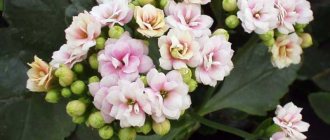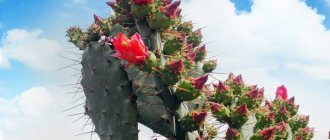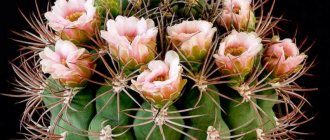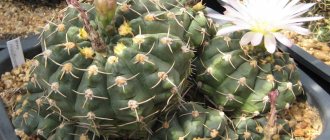Description of cacti of the genus Opuntia
The succulent plant Opuntia is a large genus of 180 species of cacti in the family Cactaceae (Cactaceae) native to the Americas. Prickly pear is found from the Peace River in western Canada almost to the tip of South America. In the Northern Hemisphere, the Opuntia fragilis variety is one of the northernmost cacti species. In the West it is also called Paddle or Nopal cactus.
Most Opuntia species are erect or spreading cacti, ranging from small, low-growing shrubs to tree-like specimens reaching 5 meters in height. Prickly pear grows in arid and semi-arid areas and can be found on sandy coastal beaches, sandy prairies, and rocky hillsides. Although they love sun and thrive in hot climates, Prickly Pear is one of the more cold-hardy species of lowland cacti. Some varieties of prickly pear can withstand temperatures as low as -10 °C.
Opuntia are easily recognized by their flat, spade-shaped stem segments, called cladodes, growing one at the end of the other. The stem plates take root easily. The edges and flat surfaces of these cladodes are covered with areoles, which always have tiny, easily detachable spines called glochids.
Photo of glochids and spines of Opuntia
Many species of Opuntia have large needles in addition to glochids, but some are armed only with small needles. They appear soft, but anyone who touches them immediately regrets it. The small size of the glochids does not cause severe pain, but it does cause severe irritation.
Prickly Pear flowers open from spring to mid-summer, usually yellow, sometimes pink and rarely white or somewhere in between. The flowers are cup-shaped and do not have floral tubes, but the pericarps resemble rounded extensions of cladodes. It is not immediately possible to determine whether the new pagon will be a flower or a new cladode, as they are identical when first emerging—often covered with cone-shaped, deciduous leaves. Some prickly pears have very juicy, fleshy fruits that are harvested and made into candy or jellies. Likewise, the stem blades, when still young and tender, are harvested and eaten as vegetables - especially in Mexico under the name Nopales.
Several species of Opuntia, including the widely cultivated Opuntia ficus-indica from Mexico, are grown for their edible fruits and stems.
Many people despise Prickly Pear, even those who like to grow cacti. However, recently there seems to be renewed interest in this genus.
How to propagate Echinocactus gruzoni
This type of cactus can be propagated at home only by sowing seeds. If you find so-called babies in a pot, then you should carefully examine the plant - in most cases this is the first signal that the flower has almost exhausted its strength and is suffering from a serious disease.
Important: if the disease cannot be identified, it is recommended to remove the shoots immediately to avoid infection.
Sowing a cactus is similar to the standard procedure for any other plant:
- First, the seeds are soaked in warm water, disinfected with a solution of potassium permanganate and then embedded in the furrows of the earth about one centimeter deep. The seed should be sprinkled with sifted soil, which is prepared according to the recommended standards. The soil is moistened by bottom watering (into a pan), not forgetting about the drainage system.
- When laying out seeds, maintain a distance of 20 mm, cover the container with film and illuminate it until seedlings appear. Plants are planted when the first needles have already appeared on them.
This is interesting: in order to see how the Georgian echinocactus blooms, you will have to wait about 20 years, because only adult specimens are capable of producing buds. The flower is yellow with a brown tint at the tips of the petals.
How to plant and grow Opuntia cactus
Growing this type of cactus can be started by sowing seeds or rooting the stem plate (cladodes). We will describe the propagation of Cladodes below and first we will talk about growing Opuntia from seeds.
How to Plant Prickly Pear Seeds
If you purchased Opuntia seeds, you need to prepare them before planting them in a pot. It is best to plant them in late winter or early spring. Start by soaking the hard seeds overnight (at least eight hours) before planting. For planting, use cactus potting mix or any light, well-drained soil. Place the seeds on the surface of the soil and press them down gently. Don't cover them up.
After planting the seeds, keep the soil evenly moist and warm until the shoots emerge. If your area is fairly dry, place a sheet of plastic or glass over the container to retain moisture. Keep the container with the seeds in a warm, well-lit place and don't be upset if they don't germinate right away. Prickly pear cactus seeds are notoriously slow to germinate, and you may have to wait up to a year.
How to grow Opuntia cactus from cuttings
Because cactus seeds take so long to germinate, rooting stem cuttings is the preferred form of propagation. Take cuttings at any time, but best in late spring or early summer (the height of the growing season).
It is very easy to cut off a segment of the stem blade, let it dry for a few days and plant the dried cutting in a pot of cactus mix or a potting mix of equal parts regular soil and sand or rough pumice. When planting cladodes, place it vertically at a depth of approximately 2.5 cm in the ground. Planting the cushion too deep will cause rot. To prevent the cutting from falling, it needs to be supported, for example, with toothpicks.
As with seeds, keep the soil slightly moist until you see signs of growth. Keep cuttings away from direct sunlight. Keep the container with the cutting in a warm, well-lit place with plenty of indirect sunlight until it takes root.
In a month, roots will form and the cutting will remain firmly in the soil.
The soil
Plant spiny cactus in a commercial cactus mix, or make your own using regular soil, sand and clay.
Light
Young Opuntia plants (under two years old) tolerate lots of bright, indirect sunlight. After ripening, it requires more open sun. In winter, keep Prickly Pear in a cool place with plenty of bright, indirect light.
Temperature
These cacti are very hardy and forgive mistakes in care. Mature plants can tolerate very high temperatures during the day and large temperature changes at night, down to -10 C.
They prefer hot, dry climates in the summer and cooler autumn and winter months. Protect your prickly pear cactus from freezing.
How to water a prickly pear cactus
Keep seedlings, cuttings and immature plants in slightly moist soil until they begin to grow. Once they have developed a couple of "leaves", you can let the soil dry out between waterings and then water thoroughly. Mature plants are very drought tolerant and require little water. Let the soil dry completely. Wait until the cactus becomes a little shriveled, then water it slowly and deeply. In winter, reduce watering by half as the plant will be dormant.
Fertilizer
Feed young plants with a water-soluble cactus fertilizer every couple of weeks. Mature plants should only be fed two to three times during the summer months. If you are growing Prickly Pear cactus for flowers and fruit, use a low-nitrogen fertilizer.
Replanting Opuntia
It is always recommended to repot plants that have outgrown the container as this will encourage new growth. If the roots get too large or the plant doesn't have enough stability in its current container, it's time to move it to a larger, more durable one.
The first thing you need to do before replanting your Prickly Pear is to make sure the soil is completely dry. Gently lift the cactus out of the pot, holding it by the base and removing any old soil.
If the cactus has damaged areas, treat them with a fungicide, then place it in a new pot and add well-drained cactus potting mix. Transplanted cacti do not need to be watered immediately. It's best to let it get used to its new environment before watering it.
Attention! When propagating, pruning or replanting Prickly Pear, you should always use thick gardening gloves and long sleeves.
If the cactus is quite large or difficult to handle, you may need a second pair of hands to hold it steady and prevent it from breaking during handling. Transplanted cacti may need external support, especially if they are tall and unstable.
Trimming
There is no need to trim prickly pear. Only in spring or late summer, remove plates that are touching each other or are damaged or poorly formed.
Sometimes you will have to wipe or rinse the cactus from time to time. Use a feather duster to wipe away dust and spray it with a hose during summer outdoors.
Reproduction
If you suddenly want to propagate Opuntia, you can do this in two ways:
- Seeds;
- By cuttings.
Seeds
This method is not very popular, because it is quite problematic. Not all seeds germinate, and it even happens that none at all. We have previously written about how to grow cacti from seeds, so the principle here is exactly the same, but there is one difference. Opuntia seeds have a rather dense shell, so they should first be rubbed with a file or sandpaper, and then soaked in potassium permanganate.
And then everything is as usual. Soil is poured into the greenhouse, holes are made there and seeds are planted. After this, you need to wait for shoots. The first transplant is performed after 3 months. More details are written in our separate article.
Cuttings
The most preferred method, which is much more effective than the previous one. There is nothing complicated about cuttings. First of all, take a well-sharpened knife and select any healthy shoot on the stem. Then, it should be cut off and then placed in an upright position in a place where it can dry a little. Usually it takes 3-4 days until a film appears at the cut site.
Also read: Echinocactus gruzoni - a spiny ball from Mexico
Next, the dried cuttings should be planted in a container with wet sand, to a depth of 5-6 cm. The container itself must be covered with cling film and allowed to be ventilated periodically, as well as occasionally watered. As soon as the seedling has roots, it should be transplanted. How to do this can be read above.
Problems in care
The main problems with a cactus are almost always related to water. If your plant becomes shriveled or soft, it needs water. Water thoroughly and then drain off excess water. If you don't do this and your plant sits in water for a significant period of time, it may begin to droop or develop dark pulp at the base. This means it begins to rot. If this happens, you may not be able to save the original plant, but you may be able to grow a new plant by taking a cutting from an unaffected area.
Diseases and pests
Root rot
appears from overwatering and cold air . Urgent pruning, growing new roots, and replanting are required.- Late blight is treated only in the early stages of the lesion. Damaged areas are cut off. The soil is changing and replanting is necessary.
- with soap suds will help get rid of mealybugs. The soil is covered with film.
- Scale insects are destroyed by treating the insect shell with vinegar or alcohol. Pests are removed manually.
- Spraying with any insecticide will help against red spider mites.
Common varieties of cacti of the genus Opuntia
There are about 180 varieties of prickly pear cactus in different shapes and sizes. Some are low growing and ideal as houseplants, while others can reach over 5m in height. When choosing the perfect Prickly Pear, think about where you want to plant it and what size you can accommodate.
Remember! If you have children or pets and want to own this wonderful plant, please note that the stem segments of most Opuntias are covered with tiny needles called glochids. Once pricked by these glochids, they will most likely remain on the skin. They may cause skin irritation.
Let us describe several examples of beautiful cactus variations.
Indian or fig prickly pear (Opuntia ficus-indica)
Formerly called Opuntia vulgaris, it is grown far beyond its native home in Mexico for its edible fruit and stem. Reaches a height of 1.8-6 meters.
Indian prickly pear
The yellow flowers are followed by orange to red oval fruits called tuna in Spanish. Young cactus stems can also be boiled and eaten. Cacti of this variety are grown as an agricultural crop.
Opuntia compressa
The cactus is native to the northeast of North America. Naturalized in Southern Europe. Flowering from July to August.
Opuntia compressed cactus
This species is hermaphrodite (having both male and female organs) and is pollinated by insects. It requires little care, is easy to grow and produces beautiful pink flowers in summer.
Prickly pear (Opuntia humifisa)
This North American variety is popular among cactus growers because it bears golden-yellow flowers in summer and its red fruits are edible.
Prickly pear prostrate
Grows up to 30 cm in height and 45 cm in width. This species is characterized by the fact that the stem leaves of adult cacti do not grow upward, but lie on the ground, which is why it got its name.
Opuntia ellisiana
This variety of cactus does not have large needles, so it is usually considered a spineless cactus with yellow flowers.
Opuntia elysiana
Well, it does have small glaucids on the pads that can cause pain in the hand. It grows up to one meter in height and its leaf blades are edible.
Opuntia microdasys or small-haired prickly pear (Opuntia microdasys)
This species of Prickly Pear is native to the American Southwest and has rabbit-shaped nopals.
Prickly pear cactus
It is a bushy perennial cactus with flattened, segmented, oval or round stems that are light to medium green in color. In summer, yellow cup-shaped flowers up to 4-5 cm in diameter bloom.
Berger's prickly pear (Opuntia bergeriana)
A shrubby species, it grows up to 4.5 m with leaf-shaped stems up to 40 cm long. This plant blooms bright red flowers in large quantities.
Berger's prickly pear
The cactus is quite frost-resistant, tolerates temperatures from up to -10 °C.
Opuntia subulata
It grows naturally only in the Andes mountains in Peru. A well-known shrubby cactus with few main branches from the base, or a small tree with a simple erect trunk and a large, almost hemispherical apex, often 3 to 4 meters in height.
Photo of Opuntia subulata
The leaves are relatively large. Red flowers bloom towards the ends of the branches, not opening widely until 6 cm long.
Brittle or brittle prickly pear (Opuntia fragilis)
So named because of the weak connection of the stem leaves - they are easily separated from passing animals, which helps in reproduction, given that flowering occurs infrequently.
Prickly pear is brittle or brittle
The plant has an unremarkable appearance. The stem segments are rarely longer than 5 m and are noticeably thicker than those of other species, often cylindrical or potato-shaped.
Main characteristics and description
Modern man has access to a wide variety of exotic plants, ranging from unusual alien orchids to prickly cacti. All this is sold in any flower shop or salon at a not so high price. One of the most common cacti on sale today is Opuntia, a photo of which, with its name and brief description, you can see in our article.
Important
The Opuntia plant (lat. Opuntia) is one of the genera belonging to plants of the cactus family (lat. Cactaceae). The species of this plant are so diverse and numerous that everyone can find a representative to their liking. Today, scientists distinguish at least one hundred and ninety species belonging to the prickly pear family.
Such cacti are widely known and cultivated all over the world, but this plant comes from America. Moreover, it grows throughout the entire continent, from Canada to the southern spurs of Argentina. True, you won’t find Prickly Pear in excessively humid tropical thickets, but in other places there is an abundance of it.
It is characterized by flattened stems-shoots that grow in large clusters, sometimes forming bushes up to four to five meters high. Prickly pear was brought to Europe and throughout the rest of the world by sailors, and now it can be found even under the snow-capped peaks of New Zealand.
The entire surface of the stems is covered with large spines, as well as small glochidia, which are easily separated from the plant. Most often, unusual flowers of orange, red or yellow bloom on such cacti, which attracts amateur gardeners. Of course, the largest specimens rarely end up in Russian homes and apartments, but they are worth talking about and showing how beautiful the Opuntia cactus can be, as can be seen in the photo.
Useful properties of the Opuntia cactus
Many scientists agree that the Prickly Pear cactus is an underappreciated plant species. In its homeland, it is widely used in cooking, medicine, and cosmetics. Let's give a few examples of using prickly pear in everyday life.
Use of Prickly Pear in Cooking
In central Mexico, the prickly pear cactus was grown as a traditional vegetable even before the arrival of the Spaniards. The stem plates or pads, called cladodes or nopales in their homeland, are widely used for food. They taste like green beans.
The fruit of the Prickly Pear is often called the cactus pear or "tuna". The taste of ripe fruits of the Opuntia cactus depends on the variety, and may resemble strawberries, watermelons, melons, figs, bananas and citrus fruits. Even the seeds can be eaten in soups or dried and ground into flour. You can find many recipes on the Internet - from appetizers, soups and salads to main courses, from vegetable dishes and bread to desserts, drinks and candies.
Use in cosmetics
- Prickly pear seed oil is a real treasure. Cactus seed extract contains rare and exceptional tocopherols (antioxidants) that are so valuable in the natural fight against aging, they help restore and protect skin surface cells.
- Prickly pear oil for the face has high antioxidant and restorative properties. This is an amazing product to naturally combat wrinkles and premature skin aging. In addition to its high effectiveness and unique and valuable benefits, it has a light texture and low fat content, which makes it easy to apply.
- Prickly pear is extremely rich in essential fatty acids, omega-6 and -9, as well as the natural antioxidant vitamin E. Cactus fruits also have beneficial properties - they are rich in amino acids that stimulate collagen production, promoting faster cell renewal.
Using the Opuntia cactus for medicinal purposes
- The juice of the stems can be used for first aid, just like Aloe Vera juice. Simply cut off a section of the leaf, crush it, and squeeze the juice onto the cut, burn, or bruise. The juice will soothe the wound. Ground or pureed stems are used as a laxative.
- Diabetes. Single consumption of prickly pear cactus can reduce blood sugar levels in some people by 17–46%. However, it is unknown whether long-term daily use can permanently lower blood sugar levels. Roasted stems of one type of prickly pear cactus (Opuntia streptacantha) have been shown to lower blood sugar levels in people with type 2 diabetes.
- Hangover . Consuming prickly pear cactus before drinking alcohol may reduce some hangover symptoms the next day. It significantly reduces nausea, anorexia and dry mouth. However, it does not reduce other hangover symptoms such as headache, dizziness, diarrhea or soreness.
Various medicines based on Prickly pear are available in many dosage forms, including capsules, tablets, powders and juices. When using commercial products, follow the manufacturers' recommendations.
How to harvest correctly
Mescaline is a valuable substance that makes the San Pedro cactus so popular. Its greatest concentration is contained in the pulp of the peel. First you need to remove all the thorns from the plant and clean off the top covering. Small pieces are consumed internally. You can also try the cactus with other plants in a decoction called “tsimora”. To do this, the cactus is dried and boiled. The concentration of mescaline can vary, depending on feeding, watering, lighting and temperature. The hallucinogenic effect after eating a cactus begins within an hour and lasts 10-12 hours. In general, the effect of the San Pedro cactus on the human body is mild, not aggressive.
In Russia, the use of mescaline is prohibited, and in some states of America in our time, Indians are allowed to grow and consume San Pedro. But there is a main condition - only for special ceremonies and rituals.
Interesting facts about the Opuntia cactus
- As mentioned above, many species of Prickly Pear cactus have edible fruits and stem segments. In Mexico, the ripe fruit is used to make desserts, drinks, appetizers, salads, soups and many other dishes, and nopales (stem segments) are used for tacos, tortillas, etc.
- In folk medicine, prickly pear juice and pulp are used to treat digestive problems, as a coagulant for open wounds, and to prevent and slow diabetes, cardiovascular disease, obesity, and other conditions.
- Some prickly pear species can be used to produce bioethanol, an alternative fuel that can replace gasoline, and eco-friendly leather.
- In Central Africa, the juice from the pads serves as a mosquito repellent.
- In rural areas of Mexico, the cactus is boiled into a concentrate and mixed with whitewash and mortar to increase the strength of buildings.
- The stem leaves can be ground and dried, and the durable fibers can be woven into mats, baskets, fans and fabrics. Pressed fibers can be used in paper production. The large spikes are used as toothpicks, needles and pins. They even use the woody segments left after the fleshy tissue has dried (in the construction of houses, rustic furniture and various trinkets).
Common prickly pear
This tree-like cactus, native to Mexico, grows up to 4-6 meters in height. From April to September, yellow, rather large flowers open on it. The segments are colored light green. They contain areoles with yellowish glochidia and gray pubescence. Some grow from one to four strong spines. On young segments in the areoles there are rudimentary leaves that are pressed to the surface of the segment, but then fall off.
Prickly pear is often used to decorate lobbies, halls, terraces, balconies and winter gardens. The optimal temperature for keeping is considered to be 8-10 degrees Celsius. But this species can tolerate temperatures down to minus 5 degrees. To grow this cactus indoors, only young specimens should be taken so that they can take root.
Small haired prickly pear
This species was first described by the German botanist and scientist Johann Lehmann back in the 20s of the 19th century, when he was studying Mexican nature in the state of Hidalgo.
This plant looks like upright shoots with a variety of leaf cakes, which are covered with tiny snow-white or brown glochidia. This cactus doesn’t have any real spines, but it’s still unpleasant to touch. Moreover, it will be difficult to remove ingrained glochidia from the skin. Fine-haired prickly pear grows up to 1 meter in height. The photo below fully demonstrates what this flat cactus looks like.
This species is used to create various compositions and arrangements, or simply planted in a pot on a windowsill facing south or southwest. It is best to propagate these cacti in greenhouses, because only there can optimal conditions be created. If they are followed, from five to twenty large buds of rich lemon color may appear on one segment. By the way, flowering in apartment conditions is not so easy to achieve.
Small-haired prickly pear can be propagated in spring and summer using cuttings. They are rooted in the sand at a positive air temperature of 20-22 degrees. The optimal soil would be a mixture of sand, peat, humus, deciduous and turf soil. Everything is taken in equal proportions. Humidity should be low.
But as the cactus grows, watering needs to be increased, and in winter – limited again. It is enough to feed once every 2-3 weeks during spring and summer with mineral fertilizer. In summer, the plant requires bright light, so during this period it is better to move the prickly pear to the open air. The temperature should be between 10-28 degrees Celsius, and in winter - about 8-12 degrees.
Popular cactus colors
Depending on the type, the succulent can be multi-colored. The most common are green, grayish, and other colors are also found.
Pink
In order for a cactus to have a rich pink color, it must be modified, artificially prohibiting the development of chloroplasts. They are responsible for all shades of green in nature. Removing the chloroplast harms the flora - without it, the process of photosynthesis is impossible. That's why there are few such plants. They are obtained this way: the modified sprout is grafted onto a healthy one.
Interesting. This procedure was invented in Japan, which is why cacti are called Japanese.
Red
A cactus can be bright red, but only on top. A striking example of this is Gymnocalycium Mikhanovich variety Friedrich. It was with him that the creation of colored succulents began.
Gymnocalycium Michanovich
The upper red part is the scion, which cannot exist without the rootstock - the lower part, a healthy, unmodified plant.
Bright blue cacti are rarely found on sale. However, in nature there are blue succulents obtained without human intervention, thanks only to nature, for example, Cereus Myrtillocactus geometrizans.
Less popular
In stores you can find indoor purple, orange, and yellow cacti. Although they are bought less often.
Interesting! In any case, bright, eye-catching colors are a sign of human intervention, not evolution.
Plants can have different colors. The most common ones include grayish and green.
Pink cacti
In order for an ornamental crop to take on this color, it needs to be slightly modified, artificially preventing the development of chloroplasts. It is these segments that are responsible for all shades of green in nature.
Note! Without chloroplast, normal photosynthesis is impossible, which has an extremely negative effect on the health and vital activity of any representative of the flora.
Pink succulents
Reds
The crop can also have a red color, but only on top. An example of such a plant is Gymnocalycium Mihanovich. It was this that marked the beginning of the creation of colored cacti.
The red upper part represents the scion, which cannot exist without the rootstock - the lower part.
Red succulents (Gymnocalycium Michanovich)
Blue representatives of cacti are extremely rare, but in nature there are species of blue color. This is their natural color, everything happened without human intervention. The name of the plant is Cereus Myrtillocactus geometrizans.
Cereus Myrtillocactus geometrizans
Lindheimer's prickly pear
This is an excellent species for home growing. It is preferred by those who dream of an exotic four-meter plant on their site. The trunk has a bush-like appearance. From it come flattened stems-plates of a somewhat elongated or oval shape. The glochidia of this cactus are translucent and slightly yellowish, which makes them even more unusual.
It is noteworthy that prickly pear blooms profusely without any effort, even in an apartment. There are a lot of buds on each segment, at least 3-5 pieces. They are small, but very beautiful, bright yellow, which is very clearly visible in the photo above. This type of flat cactus also has purple or brownish fruits. They are quite edible and taste more sweet than sour.
Fig (Indian) prickly pear
This species is specially cultivated by many Mexican residents in order to eat its fruits. They are tasty, healthy and incredibly sweet. The shape resembles a pear and is covered with thorns, which do not in any way interfere with eating the fruits. Also, fig prickly pear in a wild state is found everywhere on the southern coast of Crimea. There she concentrates in small groups.
This species is a cactus with long, flat leaves that have fairly fleshy segments, much like succulents. The stems branch noticeably, forming a wide bush. In the natural environment, it stretches 3-4 meters in height. The stems are covered with thorns, and yellow buds are formed in the upper part. After flowering, they turn into green, yellow or red fruits.
This type of prickly pear is perfect for creating a hedge. But it can also be grown indoors. In summer, the cactus needs intense sunlight. Therefore, during this period it is recommended to keep it outdoors. In winter, a cool room is more suitable. But you can also leave the plant in a warm room, since it tolerates air dried out by heating devices well.
Wild species
Some of these tough-living plants can be grown at home. Flower growers love them very much, as succulents are quite unpretentious. The most famous types are described below.
The parade of succulents opens with a very interesting representative, scientifically known as Lophophora Williamsi. Its homeland is the northern part of Mexico, Arizona. It is also known as the Peyote cactus, or Peyote. In appearance it is rather inconspicuous - a small plant with a spherical, flattened shape. It blooms with pink or white flowers. It is capable of self-pollinating, so its fruits (pink berries with seeds) appear all summer.
Peyote cactus
These succulents were widely used by Native American shamans for prophecy and healing. This is because they contain a drug – mescaline. Mescaline cacti contain more than 50 alkaloids, but it is the one mentioned above that has a hallucinogenic effect, very similar to the effect of LSD.
Important! Keeping peyote cactus in a house where children live is highly discouraged. For a child who accidentally swallows a berry, the consequences can be unpredictable.
A cactus mix is not a specific plant, but a whole list of varieties. Each of them contains different types of succulents. Popular mixes are as follows:
- Epostoa. It is distinguished by its “fluffiness”: not spines, but long soft hairs grow from the cylinder-like stem.
- Echinocactus Gruzoni. A ball-like succulent reaching 40 cm in diameter. It is entirely covered with large yellowish rosettes of spines.
- Stenocactus. This plant has a lot of ribs that bend in small zigzags. There are few rosettes of thorns.
Among this category of succulents there is one more species that is worth talking about in more detail.
Another criterion by which cacti are classified is their place of growth, and this is done purely for practical purposes for ease of orientation in the diversity of species. Depending on where they live, cacti can be forest (tropical) or desert.
Forest
About 500 thousand years ago, after a powerful earthquake, the direction of ocean currents changed towards the South American continent, which put an end to the dry weather in this part of the planet and marked the beginning of a new climatic era - the era of monsoon rains. Residents of desert and semi-desert formations - cacti and succulents - had to adapt to the new reality. Their spherical trunk completely lost its spines and was transformed into a chain of elongated-flattened segments.
For this purpose, cacti have adopted an epiphytic lifestyle, moving onto the trunks of large trees and shrubs.
Although forest cacti are not as numerous as their desert counterparts, they are no less decorative and are also of considerable interest to science. Let's look at some of them.
Not all types of cacti and succulents are suitable for keeping in an apartment, since many of them have impressive dimensions and simply do not have enough living space in such conditions. Ideal plants for indoor growing are prickly pears, astrophytums, epiphytic species - ripsalidopsis or “Easter” cacti and Schlumbergera (“Decembrists”), their ampelous and standard forms are especially decorative.
In modern phytodesign, various types of cacti and their hybrids are widely used. They are indispensable when creating florariums - closed ecosystems in glass vessels, especially with a tropical or desert theme. In order for compact mini-landscapes to be harmonious in shape, height and color of plants, it is necessary to have a good understanding of the varietal diversity of cacti and know their biological characteristics.
Ferocactus
Representatives of the genus Ferocactus are distinguished by a columnar or spherical stem shape. In the largest specimens, the height of the stems can reach 3 m, and in cross-section - 0.5 m. The shape of the central spines is hook-shaped, and they themselves are flat and can reach a length of 15 cm. The color of the flowers is red, yellow, orange, the shape is bell-shaped, length and diameter - 2-6 cm. There are many popular species, Latispinus is especially interesting.
READ MORE: Types of spruce 96 photos European Korean Sitka and other varieties of spruce Tompa Froburg Kupressiana and other varieties with names
This is a highly decorative species with a compressed spherical or flat stem and an amazingly beautiful prickly outfit of wide, highly flattened needles: none of the cacti known to science are so flat. All thorns grow upward, with the exception of the lower one, which is intensely red or bright yellow in color with a hook-shaped tip bent down.
Notocactus
These small, ball- or cylinder-shaped cacti have distinctive, expressive purple flower stigmas. The appearance of lateral shoots in notocacti is an extremely rare phenomenon. Wild plants can grow a maximum of 1 m. Young plants have delicate spines, become coarser with age, and the initially gray color gives way to bronze.
This is a bright representative of the flora of the tropics, a succulent, a native of humid evergreen Brazilian forests, leading an epiphytic or lithophytic lifestyle. Hatiora, also known as ripsalidopsis, is a completely leafless plant with segmented, highly branched stems, small fragments of which can be flat or cylindrical. The shoots are drooping and erect; with age they become lignified, transforming into a trunk.
Flowering occurs at the end of tropical summer, when winter ends in the northern hemisphere. In some species, flowers are formed in the upper part of the stems, in others - along the entire length of the stem. Most often there are plants with red, pink flowers, less often - yellow flowers.
Lobivia
This is one of the most suitable classic species of cacti from the genus Echinonopsis for beginner hobbyists. Lobivias are quite compact and bloom without problems. These plants look different. Some forms are characterized by the presence of an egg-shaped stem with rounded ribs and yellow needles; in large-flowered varieties, the axial part of the shoot is spherical in shape with pronounced ribbing. Traditional flower colors are red and yellow.
Their wild relatives behave in a similar way, forming densely populated colonies in their natural habitat.
Prickly pear
Basically, prickly pears grow in the form of shrubs with erect or creeping shoots; tree-like forms are less common. All plants of this genus are characterized by the presence of succulent, articulated branches, glochidia (microscopic bristles) that are invisible to the naked eye, and single flowers. The color of the flowers is yellow, orange, red.
Rebutia
These perennial small succulents have long won the hearts of our cactus growers thanks to their beautiful, sometimes repeated flowering. The plants are distinguished by a fleshy spherical stem with a slightly depressed crown, moderate ribbing with a spiral arrangement of ribs, divided into tubercles. The areoles often located on them produce many small bristly spines. The maximum diameter of adult plants is only 10 cm; in the smallest forms it does not exceed 5 cm. However, for such a modest size, the flowers of these cacti are quite large, and this contrasting combination looks very impressive.
The colors are impressive with a variety of shades from red, cream and pink to expressive carrot and yellow. In terms of care, rebutions do not require anything beyond what is necessary for the full development and growth of most cacti.
Mammillaria
The article has already mentioned amazing representatives of this diverse genus. Such charming little ones leave few people indifferent, because they have incredibly beautiful blooms. At the top of the cylindrical forms, a spectacular “diadem” of several miniature flowers is formed. Globular specimens are often completely covered with flowers with narrow petals.
Ariocarpus
Due to the presence of a succulent rhizome, which has an external resemblance to a turnip or pear, Ariocarpus calmly tolerates long periods of drought. The stems of these succulents are pressed to the surface of the ground. The appearance of fleshy, wrinkled shoots in the shape of triangles, painted in rich green, brownish or gray, is also interesting.
When flowering, Ariocarpus, which in ordinary life looks rather inconspicuous, is completely transformed, blooming bell-shaped flowers with elongated, narrow, glossy petals. The color of the flowers can be whitish, various shades of pink, or lilac.
Cleistocactus
Representatives of this genus can be recognized by columnar stems, erect or creeping along the surface of the ground, attractive spines and unusual flower shapes. In wild species, shoots can reach 3 meters in height. The ribbing of the stem is weakly expressed. Tufts of bristly spines grow from numerous areoles, almost completely hiding the shoots. The fact that the thorns are grayish, golden, brownish, and white in color makes the appearance of cleistocactus even more expressive.
Opuntia brittle
This is another species that can be classified as home flat cacti. This is a bushy, erect, low plant that consists of noticeably branched stems. Opuntia differs in that the lobes are not flattened, but rounded. The segments do not exceed 2-3 centimeters in length. The segments are brittle and fall off easily, which is why the cactus got its name. The areoles are small and contain very short white spines. During flowering, pale yellow buds with green stigmas are formed.
Aciculata
On almost every corner of dry, hot Mexico there is another flat cactus. It has several names. “Aciculata”, “Spiky Chenille Hat”, “Old Cowboy’s Mustache”. The names appeared due to the numerous glochidia up to 1 centimeter long, which dot the surface of the flattened, rounded stems. They themselves are colored greenish, and sometimes gray or even bluish.
Any gardener will appreciate flowers of this species. They are quite large (10 centimeters in diameter) and have a yellow, orange or deep red tint. The fruits, as in the case of white-haired prickly pear, are also edible. The shape resembles a pear, only covered with small spines.











